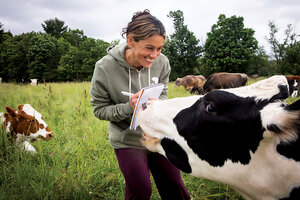Should we care what cows think? How readers broadened my view of animals.
Good journalism opens minds and invites readers to see things differently. Sometimes, readers can have a similar effect on journalists.

Staff writer Stephanie Hanes “interviews” Pietro the steer while on assignment at Farm Sanctuary in Watkins Glen, New York, June 10.
Melanie Stetson Freeman/Staff
In the tense final days of the 2024 U.S. presidential election, I was spending much of my professional life thinking about a cow.
This may seem odd, even for a writer focused on the environment. After all, there was no shortage of breaking news about the climate, not to mention other big news subjects.
But that cow was haunting me.
Staff photographer Melanie Stetson Freeman had photographed her in a sophisticated methane-measuring chamber, as part of a story about the scientific quest for “climate-friendly” milk. The structure wasn’t tiny – far larger, in fact, than what cows in most dairy barns experience – but it sparked reader questions.
We reassured them that Cornell University, home of the study, adhered to animal welfare regulations. But there was one query I couldn’t shake. Did I think, this reader asked, that the cow liked being in that metal-and-glass contraption?
It made me wonder: Do I know what cows like, let alone think? Does anyone? And, given the human problems in the world, should we care?
Later on that same reporting trip, Melanie and I visited Farm Sanctuary in Watkins Glen, New York. There, a huge steer named Greg pranced up to us, two-stepping in a way that dog owners would recognize as a clear “play with me” motion. “He’s super friendly,” said Gene Baur, the sanctuary’s founder, who went on to explain how research shows that bovines form family groups, recognize human faces, and demonstrate emotions like joy and sadness.
This prompted me to learn what else researchers have discovered about other animal species. It turns out, as I write in the cover story featured in the Nov. 18 issue of the Monitor Weekly, that a growing body of scientific research paints an increasingly complex, emotional, and sensory-rich portrait of the world, with animals from goats to octopuses to bumblebees exhibiting different forms of what’s often called consciousness.
This brings up big ethical questions, as well as a challenge: Can we live harmoniously and kindly in a world of other beings who have different experiences from ours, but who also share deep commonalities?
It is a question, of course, that goes well beyond my cow.
Perhaps, at a time of political division and misunderstanding, the inner lives of animals offer clues for how we can live a bit more gently, understand differences better, and see ourselves not as separate and superior but as part of one, sparkling tapestry.

